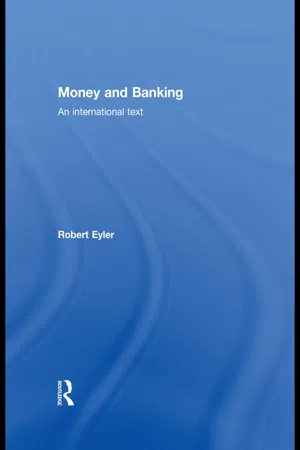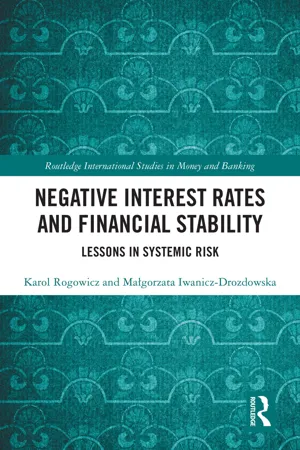Business
Nominal Interest Rate
The nominal interest rate refers to the percentage of interest charged on a loan or earned on an investment without adjusting for the effects of inflation or compounding. It represents the actual rate stated in the loan or investment agreement. While it provides a straightforward measure of the cost of borrowing or the return on investment, it does not account for changes in purchasing power over time.
Written by Perlego with AI-assistance
Related key terms
3 Key excerpts on "Nominal Interest Rate"
- eBook - ePub
Money and Banking
An International Text
- Robert Eyler(Author)
- 2009(Publication Date)
- Routledge(Publisher)
Interest rates come in many forms, all with the same basic set-up. An interest rate includes measures of risk, both general and very specific. When you borrow money, the rate at which you borrow is the nominal rate. This rate is the stated interest cost or return of a financial investment. There is also a real rate, but what separates the two? The difference between nominal and real variables in economics has to do initially with inflation, or purchasing power erosion, and other risks. In its most basic form, a Nominal Interest Rate has the following equation:R = r + P(2.1) where R is a nominal rate, r is the associated real rate and P is the expected inflation rate. Equation 2.1 assumes the only risk to be inflation. The best way to think of the real rate of interest is what the lender wants to receive as revenue, less the calculated risks. The nominal rate is the sum of the real rate and the “expected” inflation rate, which is a calculated guess and not the actual inflation rate. When a lender provides a loan, the lender must make conjectures concerning what the risk of future inflation may be. Unless the interest rate is allowed to adjust with new inflation information, the lender bears that risk directly; when inflation rises without the nominal rate changing, the real value of her loan gets smaller. Both the borrower and lender make decisions based on their individual assessment of the real rate of interest. Even though the borrower writes a check every month to the credit card company based on a nominal rate, the lender is seeking protection of the real rate as the driving force behind providing credit. If all the expected risks play themselves out as predicted, the borrower and lender pay and receive the real rate respectively.We will discuss later the difference between fixed and variable rates of interest, but keep in mind that few assets, real or financial, can circumvent the risk of inflation. Inflation is also a representation of time in financial markets, specifically eroding nominal income and wealth.Defining interest rates
The cost of borrowing
This is the classic role we think of interest rates playing in finance, an explicit cost of consuming beyond one’s income or wealth by choice. As a corollary, it is also the opportunity cost of consuming, regardless of the entity being a net consumer or not. A net consumer is a household that both consumes and saves, but consumes more than its income in net. If one consumes anything, there is lost interest revenue from saving the resources otherwise; however, financial leverage may be a decision because the cost of debt is less than the return to savings. Households are willing to bear this cost, however, at some level because of necessity and because of satisfaction or utility otherwise, an issue discussed in more detail in Chapter 9 - eBook - ePub
Negative Interest Rates and Financial Stability
Lessons in Systemic Risk
- Karol Rogowicz, Małgorzata Iwanicz-Drozdowska(Authors)
- 2022(Publication Date)
- Routledge(Publisher)
It was noted by J. Tobin (1961) who, as a neo-Keynesian, defined the interest rate as a premium for giving up liquidity, that is, for taking a risk of investing in securities. In that view, the interest rate was interpreted as a monetary phenomenon with some real sphere elements. In his theory, the interest rate, on the one hand, defines the interest level for bank loans and financial instruments and it was also considered a possible rate of return on real capital goods (Szydło, 2002). In this context, the varying importance of interest rates from theoretical perspectives may also be addressed. Much as the classical theory perceived the real long-term interest rate being of key relevance in determining economic processes, J.M. Keynes considered the real short-term Nominal Interest Rate to prevail (Duménil and Lévy, 1999). Important relations among various categories of interest rates produce a simplified approach in economic models which is restricted to just one general interest rate theory being applied. It is often assumed that changing the level of one interest rate type usually implies the same focus for change in the other categories. Still, in the context of negative interest rates, it is crucial to differentiate between the nominal and real, as well as short- and long-term categories, to be elaborated on in subsequent sub-chapters. 2.1.2 Nominal and Real Interest Rate The differentiation between real and Nominal Interest Rates, originally made by I. Fisher, became vital for economic considerations. The Nominal Interest Rate defines an alternative cost incurred in keeping funds as cash, i.e., so-called cost of lost interest (Begg et al., 1994). In turn, the real interest rate specifies the increase of the purchasing power of money to be attained if invested at a given nominal rate. In line with an original Fisher effect, a difference between those two was the level of inflation - eBook - ePub
- John Smithin(Author)
- 2008(Publication Date)
- Routledge(Publisher)
In fact, he goes on to point out that in many cases the real rate in the above sense is actually more variable than the nominal rate. This is simply because the nominal rate is not always adjusted promptly when the inflation rate changes. It seems clear also, that in such a case it will be the variable real rate that will affect economic decision-making rather than the “sticky” nominal rate. It is implicit in these observations, however, that the real interest rate could be made more stable (for example, by central bank policy) if the nominal rate was so adjusted. These ideas do militate against the idea that there is any such thing as a “natural” real rate, but not against the notion of a real rate of interest as a definitional concept – simply the difference between nominal rates and expected inflation. The Chicago-trained economist Burstein has similarly distinguished between a natural rate theory of real interest rate determination, and the definition of the real (inflation-adjusted) interest rate. According to Burstein (1995, 1), in a phrase that neatly ties together the two alternative meanings of the term, there can be both a “real theory of the real rate of interest” and also a “monetary theory of the real rate of interest”. The former is an accurate description of the classical theory, whereas the latter is what Burstein would attribute to Keynes and others. 1 The term structure of interest rates The concept in theoretical finance of the “term structure of interest rates”, illustrated empirically by a graph of the “yield curve”, refers to the relationship between interest rates on debt instruments with different terms to maturity. The annualized yields on instruments with (say) less than one year to run, are generically referred to as short rates, and those with several years to run as long rates
Index pages curate the most relevant extracts from our library of academic textbooks. They’ve been created using an in-house natural language model (NLM), each adding context and meaning to key research topics.


